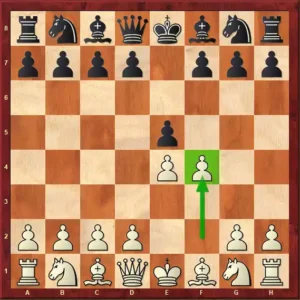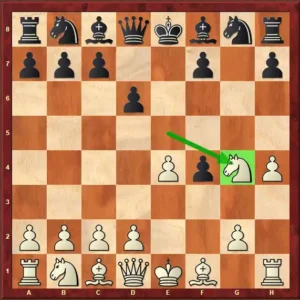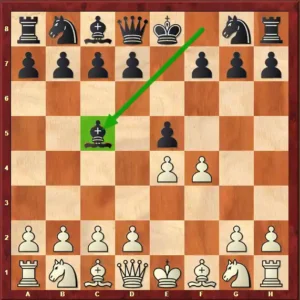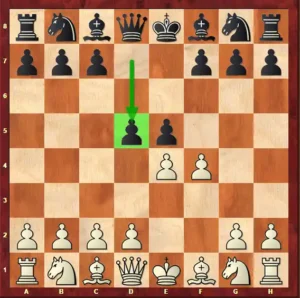King’s gambit chess opening starts with the move 1.e4 e5 2.f4. In this opening, white sacrifices a pawn on the kingside and that’s why it is known as king’s gambit chess opening.
It was one of the most popular openings until the late 19th century and it was regularly employed by top attacking chess players of that time but as the chess engines started having more influence on player’s opening preparation; this opening saw a drop in popularity because chess engines do not like this opening.
At club level, king’s gambit chess opening remains perfectly playable and you may surprise your opponent with king’s gambit opening as many people do not expect their opponent to play it so they don’t prepare thoroughly against it.
Is king's gambit chess opening good for beginners?
Yes, King’s gambit opening is a good chess openings for beginners as you get easy piece development and good piece activity for the sacrificed pawn.
Kings’ gambit chess opening initial moves
White’s idea is to sacrifice a pawn to have more control over the central squares and rapid development of his pieces. White hopes to later regain the pawn while maintaining his lead in development.
1.e4 e5 2.f4 white is putting pressure on the e5 pawn. After the exchange of f4 and e5 pawns, white’s f-file will become open. White will put the rook on f1 and from bishop on c4, both pieces will put pressure on black’s f7 pawn.

Black has two ways to deal with the gambit:
If black plays 2…exf4 capturing the pawn then it becomes king’s gambit accepted.
If black plays any other move, then it becomes king’s gambit declined.
In this article, we are going to look at both of these possibilities.
King’s gambit accepted
It leads to a position where white is a pawn down but your piece activity compensates for the loss of material. In such unbalanced situations, you will get a lot of attacking chances.
After 2…exf4 white can not play 3.d4 (taking control over the centre directly) because black will play 3…Qh4+ giving a check to white’s king.
So after 2…exf4 you should play 3.Nf3 preventing black’s …Qh4+.
Classical variation:
In classical variation against king’s gambit chess opening, black first captures the f4 pawn and then usually follows up with …g5 to protect the extra pawn.
After the moves, 1.e4 e5 2.f4 exf4 3.Nf3 g5 black decides to hang onto the extra pawn.
4.h4 g4 5.Ne5 d6 6.Nxg4 and white regains the pawn with a complicated position.

Muzio gambit:
It occurs after the moves 1.e4 e5 2.f4 exf4 3.Nf3 g5 4.Bc4 g4
And now white plays 5.0-0 ignoring the threat on the f3 knight.
5…gxf3 black of course captures the knight.
6.Qxf3 here white has developed so many pieces and black has not developed a single piece and this gives a white an initiative in the position but with accurate play black can defend successfully.

In a practical game, it will be much easier to play this position from the white side because many of your pieces are developed and your attack flows naturally while black has to play accurate moves to survive. You have good chances to play for direct attack on black’s king.
Fischer’s defense:
Grandmaster bobby fischer recommended the move 3…d6 against the king’s gambit opening in an article. Against this defense also, you can simply develop your knight bishop to c4 and go short castling.
King’s gambit declined
In king’s gambit opening, black does not have to take the pawn and accept the gambit. Black has many ways to decline the gambit and we are going to look at two major options.
Classical defense 2…Bc5:

In classical defense against king’s gambit chess opening, black simply develops his bishop on second move.
White cannot play 3.fxe5 because of 3…Qh4+ and white will lose material so white has to play 3.Nf3
Now after 3.Nf3 d6 4.c3 Nc6 5.d4 you can immediately expand in the centre. Next, you develop your minor pieces and go castle.
This variation generally leads to relatively calm positions, instead of sacrificial attack you need to play the game more patiently.
Falkbeer countergambit 2…d5

This is an aggressive option from the black’s side against king’s gambit chess opening. Instead of taking the pawn on f4, black himself sacrifices a pawn and plays the gambit. This is known as falkbeer counter gambit.
Black’s idea is to have an easy piece development in return for the pawn. After, 1.e4 e5 2.d4 d5 3.exd5 e4 you can develop your light squared bishop to c4, develop the knight to e2 and go short castling.
King’s Gambit chess opening traps
Out of many traps in the king’s gambit opening, I want to show you two traps where your opponent may go wrong and you will get a quick win.
Queen trap in king's gambit chess opening:
Is king's gambit chess opening good for beginners?
After, 1.e4 e5 2.f4 Bc5 black plays king’s gambit declined classical defense.
3.Nf3 d6 4.c3 Qe7 black is trying to put pressure on e-file.
Now we play
5.d4 exd4 6.cxd4 and black can play 6…Qxe4+ winning a pawn.
It looks like that black has managed to win a pawn but actually it’s a trap. Now we play
7.Kf2!!

Our king was attacked so we saved it and now black’s bishop is under attack.
Black plays 7…Bb6 to save the bishop. 8.Bb5+ Kd8 9.Re8
It does not matter what black plays, black will lose the game. If black plays 9…Qf5 then 10.Rd8 is a checkmate and if black defends the checkmate then black will lose his queen.
Knight sacrifice in king's gambit chess opening:
Now let’s look at a trap where black plays king’s gambit opening accepted.
1.e4 e5 2.f4 exf4 3.Nf3 g5 4.Bc4 h6 black protects the g5 pawn. Now we play 5.h4 to attack it and black plays 5.h4 f6 to defend the g5 pawn but actually it’s a mistake because now we can play a beautiful knight sacrifice.
6.Ne5!! sacrificing the knight to open the diagonal of the queen.

6…fxe5 7.Qh5+ we bring the queen to attack black’s king.
7…Ke7 8.Qf7+ Kd6 9.Qd5+ Ke7 10. Qxe5# It’s a checkmate.
In king’s gambit chess opening, this Nxe5 idea is worth remembering because you will get many opportunities to use this idea in a similar way.
Conclusion
King’s gambit chess opening is a perfectly playable opening especially at the club levels. If you are willing to take risk for initiative and attacking possibilities then you should use king’s gambit opening. It will come as a surprise for your opponent and you will get unbalanced position from where you can play for the win.

